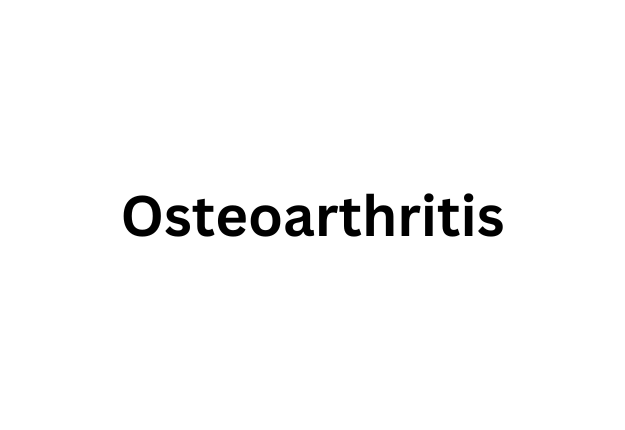Osteoarthritis is a common form of arthritis that affects millions of people around the world.
Osteoarthritis is a painful condition that occurs when the layer around the bone and/or joint (cartilage) breaks down. Osteoarthritis can occur in any joint in the body, however, the joints most commonly affected are the feet, knees, hips, spine, and hands. Osteoarthritis is irreversible, although the pain can be managed through various treatments.
Symptoms
Symptoms of Osteoarthritis may be mild at first; however, they will gradually become more apparent over time. Symptoms of Osteoarthritis are:
- Sharp or burning pain, tenderness, stiffness, and swelling
- Inflexibility, or noticeably poorer flexibility
- Popping, cracking, or a grating sensation during movement
- Bone spurs – projections in the area(s).
- Muscle weakness
Diagnosis
Your doctor or nurse practitioner will check for the common symptoms listed above. He or she may also request a blood sample, joint fluid analysis, an MRI, and/or an X-Ray.
Blood sample
Blood samples will not determine if you have Osteoarthritis, however, they can help confirm whether or not you have any other conditions that are causing your symptoms. This helps to rule out other conditions.
Joint Fluid Analysis
Joint fluid analysis requires fluid to be taken from the area of concern. The results will be able to reveal whether or not the area is inflamed. Joint fluid analysis can also determine whether or not you have another condition.
MRI
In a difficult case, an MRI can help professionals view images of bones, tissues, and cartilage.
X-Ray
An X-Ray can show bone spurs and loss of cartilage around bones and joints.
Treatment
There are a variety of treatments that can help ease Osteoarthritic pain, including medications, surgery, and therapy.
Medications
- Acetaminophen: used to treat mild to moderate pain
- Duloxetine: used to treat chronic pain
- Ibuprofen: used to treat mild to moderate pain
- Nonsteroidal anti-inflammatory drugs (NSAIDs): NSAIDs are over-the-counter drugs. If you require a stronger medication, your doctor or nurse practitioner can prescribe you a stronger NSAID
- Gels and/or creams used topically on the affected area(s).
Surgery
- Cortisone injections or lubrication injections: help to relieve pain
- Joint replacement: often replaced with plastic or metal
- Realignment of bones: for severe conditions
Therapy
- Occupational therapy: seeing an occupational therapist will help you learn how to carry out everyday tasks in ways that will benefit you. He or she will likely recommend supportive devices
- Physical Therapy: a physical therapist can help with strengthening exercises to reduce symptoms
Exercise
Occupational or physical therapy: your therapist will help you with, or assign you with daily exercises. However, if you do not take the therapy route, keep in mind it is important to do light exercises at work and around the house to keep your joints moving.
Hot or cold compresses
Applying a hot pack to the inflamed area before partaking in physical activity will help with effective movement. Application of a cold pack to the inflamed area can help to temporarily relieve pain symptoms.
Support devices
A device such as a cane, walker, shoe insert(s), and more, may help take the pressure off the inflamed area(s). Assistive tools can also be used around the home (i.e., grab bar in the bathtub) to take the pressure off the inflamed area(s).
Other
Other options include acupuncture, Omega-3 fatty acids, turmeric, ginger, green tea, massages, Reiki, and Epsom salt baths.
Prevention
To help prevent Osteoarthritis, make sure to stay active, and maintain a healthy diet and weight. You can bike ride, walk, run, and/or take up yoga to stay active. Try to avoid or eliminate foods or drinks that cause inflammation, these include alcohol, aspartame, salt, trans and saturated fats, sugar, rice, white bread, and pasta.
Written by Laura Laroche, HBASc, Medical Writer
References:
Natural Home Remedies for Osteoarthritis: What Works? 2019, https://www.healthline.com/health/osteoarthritis/natural-home-remedies, 6 June 2019.
Osteoarthritis. 2018, https://www.healthlinkbc.ca/health-topics/hw125723, assessed 6 June 2019.
Osteoarthritis. 2019, https://www.mayoclinic.org/diseases-conditions/osteoarthritis/diagnosis-treatment/drc-20351930, assessed 6 June 2019.
Osteoarthritis (OA). 2019, https://www.merckmanuals.com/en-ca/home/bone,-joint,-and-muscle-disorders/joint-disorders/osteoarthritis-oa, assessed 6 June 2019.



